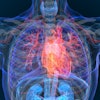
The combination of artificial intelligence (AI) and a new noninvasive cardiac imaging technique can perform comparably to current imaging tests used to detect coronary artery disease (CAD) -- without requiring cardiac stress, contrast agents, or radiation exposure, according to research published recently in PLOS One.
Researchers led by Dr. Thomas Stuckey of Cone Health in Greensboro, NC, and senior author William Sanders Jr. of technology developer Analytics 4 Life (A4L) developed a machine-learning algorithm to analyze cardiac phase space tomography (CPST) -- a novel imaging method that uses a handheld instrument to capture the heart's resting phase signals. In testing, the algorithm was more than 90% sensitive for diagnosing significant CAD.
Currently, screening tests for CAD are expensive, typically require physical or pharmacologic stress, and commonly involve radiation exposure. In patients with chest pain, functional testing and CT angiography (CTA) serve as gatekeeping tests for risk stratification and to identify individuals who would benefit from angiography, according to the researchers.
"Little has changed with regard to the accuracy of these technologies in the last decade, and better tools for screening CAD are needed," they wrote.
In their study, the researchers sought to assess the diagnostic performance of CPST for assessing CAD in patients referred for coronary angiography due to chest pain. With CPST, 10 million data points are acquired from the patient's resting phase heart signals, which are transferred along with ancillary patient-specific information to the cloud for evaluation by a machine learning-based analytic engine. These results are subsequently displayed as a phase space tomography model on a web portal for review by physicians, according to the researchers. A4L is developing CPST and funded the study (PLOS One, August 8, 2018).
The researchers developed and tested the machine-learning algorithm using phase signals from 606 subjects who presented with chest pain at 12 U.S. centers. Phase signals were acquired at rest prior to angiography. Of the 606 participants, 159 (31%) had obstructive coronary lesions.
To train the algorithm to analyze the unique features associated with flow-limiting CAD, mathematical and tomographic features were extracted from the phase data and paired with the angiography results -- the gold standard for the study. The algorithm was trained using data from 512 subjects and then prospectively tested on the remaining 94 participants.
| Performance of machine learning + CPST to predict CAD | |
| Sensitivity | 92% |
| Specificity | 62% |
| Positive predictive value | 46% |
| Negative predictive value | 96% |
The researchers noted that the algorithm was optimized to maximize sensitivity. The algorithm's specificity level is similar to that of other functional tests, according to the researchers.
"[CPST analysis] exhibits comparable diagnostic performance to existing functional and anatomical modalities without the requirement of cardiac stress (exercise or pharmacological) and without exposure of the patient to radioactivity," the authors wrote. "This technology may provide a new and efficient technique for assessing the presence of obstructive coronary lesions in patients presenting with chest pain suspected to be of cardiac etiology."




















